
Banca Malatestiana
Palazzo Ghetti
Via XX Settembre 63
Rimini (Italy)
Info and free tour
tel. 0541315811 -
info@bancamalatestiana.it
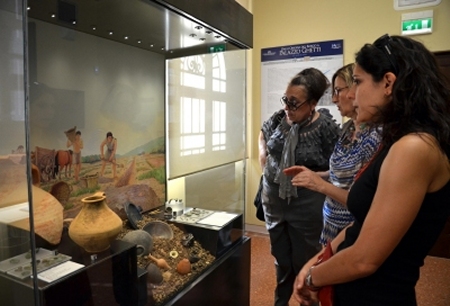 We
chose this building as our bank’s ideal head office due to its deep-rooted links
with the history and collective imagination of this city and also with the aim
of saving from disrepair the fascinating former match factory owned by Cavalier
Ghetti. We commissioned meticulous scientific restoration work on it so it would
return to how it looked almost two hundred years ago. Beyond even our greatest
expectations, excavations in the building’s courtyard revealed a wealth of
archaeological artefacts, dating from various centuries of history. We now wish
to share with those who are excited to see what was brought to light this small,
but to us very dear, museum open to the entire city.
We
chose this building as our bank’s ideal head office due to its deep-rooted links
with the history and collective imagination of this city and also with the aim
of saving from disrepair the fascinating former match factory owned by Cavalier
Ghetti. We commissioned meticulous scientific restoration work on it so it would
return to how it looked almost two hundred years ago. Beyond even our greatest
expectations, excavations in the building’s courtyard revealed a wealth of
archaeological artefacts, dating from various centuries of history. We now wish
to share with those who are excited to see what was brought to light this small,
but to us very dear, museum open to the entire city.
Banca Malatestiana President, Enrica Cavalli
The archaeological excavations conducted during the restoration of the
Palazzo Ghetti in Rimini, made possible by the collaboration between the
Archaeological Superintendence of Emilia-Romagna and Banca Malatestiana, have
allowed important evidence to be recovered, concerning not only the history of
human activities in this area, from the Roman era through to the present day,
but also the changes that the land itself has undergone during this long period
of time. The significance of the information gathered, the results of which are
presented here preliminarily, the interesting features of some of the structures
revealed and the objects found during the excavations made it necessary to
identify the most appropriate way to present these discoveries, making them
accessible to the public. The proposal of an exhibition space in the building
restored to house the head offices of Banca Malatestiana was therefore received
favourably by the superintendence, believing this option to be a further step in
the safeguarding and enhancement of our cultural heritage that started with the
archaeological excavations and now continues with this display project. It is
therefore particularly important, at this present moment in history, to be able
to recognize this initiative as an example of the promotion of the cultural
heritage, and in particular of the archaeological treasures that form such an
important part of our story.
Soprintendente per i Beni Archeologici dell’Emilia-Romagna, Filippo Maria
Gambari
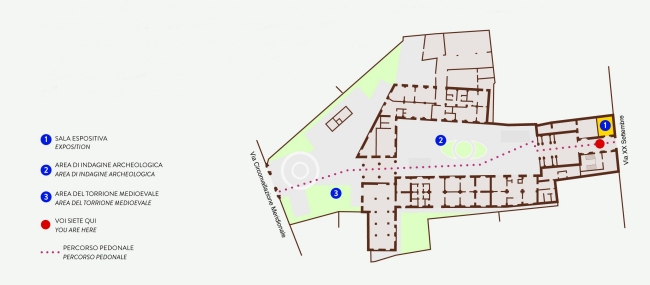
Display itinerary
Notes on the history
Around the Italian Unity (1861), between the few industries of Rimini
there was the Nicola Ghetti’s match factory, that in 1866 has more than 350
workers, mostly women.
Established in 1837 in a different location, it was definitively fixed in 1857
in this building, that includes the factory and Ghetti’s mansion. It had been
designed by architect Giovanni Benedettini, who worked together with architect
Poletti at the realization of Galli Theatre in Cavour Square and designed other
important buildings in town.
In origin the residential wing was surmounted by an attic with a terrace toward
XX Settembre Street; on the attic there was an octagonal turret with two clocks
and a lantern on the top. The match factory was considered all along the
nineteenth century a very advanced building, because of its sanitary equipments,
but once dead Nicola Ghetti, went in crisis with the depression of the late
nineteenth century, was sold in 1896 and gave up the activity in 1908. The
mansion, collapsed the turret with the earthquake of 1875 and the turret with
the one of 1916, in the Twenties lost both the attic and the terrace and was
covered with the actual roof. Even the three wings of the factory lost their top
floor.
The whole building was sold and converted to residential use, divided in flats,
with stores and workshops at the ground level.
The building fell into decline till 2000, when the Municipality of Rimini,
become owner of it, restored the only residential wing, in order to turn it into
offices. In 2005 Banca Malatestiana bought by auction the building and started
an integral restoration to realise its new headquarter, according the project by
Cumo Mori Roversi Architects, ended in 2013.
The restoration (2007-2013)
The aims of the project were the realization of Banca Malatestiana new
headquarter and the recovery of the urban value of the building, with the inner
route. The building, that was in a state of utter neglect, showed itself as the
result of joining of different parts. The residential wing, even if recently
renovated, did not show appearing traces of its original decoration any more,
but the two painted ceilings at the ground level. Also the external walls looked
very different from the original aspect. By a special study on the plasters it
has been possible to find out and reproduce the original finishing and colours
of the external walls; the paintings on the intrados of the main stairway have
been discovered and restored. Almost all the technical devices and implants have
been concentrated into new dedicated spaces in the underground of the big
rectangular court, in order to preserve the ancient rooms.
The most important implication of the realization of the new underground has
been the archaeological excavation that interested the whole court and the
outdoor rear area, under the direction of the Archaeological Superintendence.
The project , approved by the Architectonical Superintendence, aimed at
recovering the internal spaces, by introducing a new system of partitions, that
did not reach the ceilings and the roof, keeping them in complete evidence.
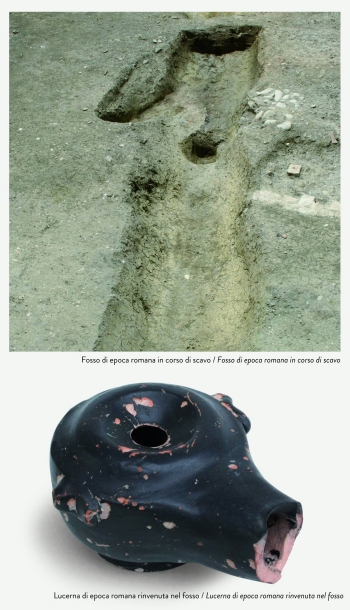 Archaeological
excavations
Archaeological
excavations
Excavations carried out in two courtyards areas of the Palazzo Ghetti in
2009 and 2010, under the supervision of the Archaeological Superintendence of
Emilia-Romagna, revealed traces related to the production activities of the
18th-century match factory. At the depth of one metre, a number of mediaeval
structures of the old San Genesio quarter, now San Giovanni, were discovered.
Houses, shops and storerooms opening onto a street and courtyards with waste
tips containing a wealth of materials gave an interesting view of daily life in
Rimini in the 14th and 15th centuries, when it was ruled by the Malatesta
dynasty. The old quarter was built over a cemetery dating back to the Roman
Imperial period, situated as was customary along a main road outside the town,
and in this case the ancient Via Flaminia, now Via XX Settembre, which started
from the Augustus Arch and led to Rome. Finally, beneath the remains of crop
cultivations, drainage trenches dug by the Romans from the middle of the 3rd
century BC onwards to reclaim the local marshland were found. The ditches were
subsequently filled in with soil and refuse, which yielded several pieces of
pottery and other important items for the history of Rimini.
FROM ROMAN ERA TO LATE ANTIQUITY
The origins of the Quarter
After founding the colony of Ariminum in 268 BC, the Romans started to
reclaim and divide the surrounding land using the method of centuriation,
consisting in a grid of roads and drainage channels oriented towards the main
cardinal points, or following the slope of the land or the presence of
watercourses. The ditch found in the excavation of the main courtyard of the
Palazzo Ghetti dates back to this period, running from north to south, parallel
to the “Cardo Maximus” of the city, the present-day Via Garibaldi and Via IV
Novembre. Towards the south, the ditch became wider and deeper, perhaps to allow
it to collect water better. It remained in use until at least the 1st century
BC, and was filled in with soil mixed with numerous fragments of black-gloss
pottery mainly from the 3rd and 2nd centuries BC, but in some cases probably
from the 4th century, including plates, lamps and jars, some with engraved
letters. Numerous sections of flooring slabs were also found, perhaps from
masonry water tubs. Spacers from pottery firing and large blocks of burnt
fireclay found in the ditch filling suggest that there was probably a pottery
kiln nearby. Two artefacts in terracotta are of particular interest, one a small
domestic ceramic altar painted with the image of an ox, and the other an antefix
showing a winged female figure. Several coins, fragments of amphorae, bricks and
metal objects were also found together with these materials, including a Roman
fibula that seems to have been modelled on Celtic designs.
The filled-in ditch was perhaps replaced by or linked to smaller channels
probably associated with the cultivation of the fields
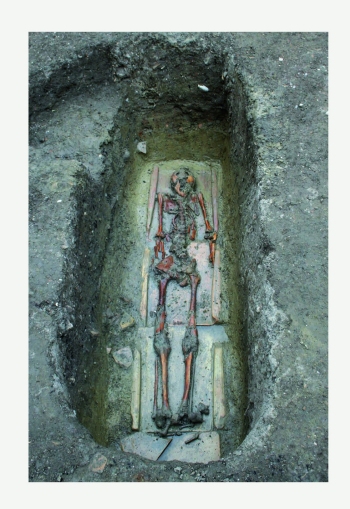 The
Necropolis and the well
The
Necropolis and the well
Between the 1st and 3rd centuries AD the level of the countryside gradually
rose, and a number of small furrows and residues of fires suggest activities
linked with agriculture.
Later, in the 3rd and 4th centuries AD, the area was marginally occupied by a
series of burials, probably on the edge of the necropolis that developed
alongside the Via Flaminia, characterized in many cases by monumental burials.
The tombs found during the excavations were more modest, with a burial chamber
made from roofing tiles, inside which the body was laid for interment.
During the excavations a well was also discovered, perhaps originally lined with
cobblestones. The filling of soil mixed with masonry yielded the neck of an
amphora and an intact jug.
The area probably continued to be used as a burial site up to the 5th or 6th
century AD, as indicated by a number of coins found in some graves.
An interesting hypothesis, which still however remains to be proven, could link
these burials with the nearby Santo Stefano Church from the early Middle Ages,
which over the centuries became the present-day San Giovanni Battista Church.
COMMENTARIES
ROMAN CENTURIATION IN EMILIA
When a new territory was occupied, it was common practice during the
Roman Republican and Proto- Imperial periods to allocate the lands to settlers.
These areas underwent centuriation, in other words they were divided into
regular, square sections called centuries, which were square and had straight
roads and right-angle junctions, from which single plots of land were obtained.
The procedure was standardized and was carried out by specialists using tools
that permitted the exact identification of the cardinal points or “grome”. In
Emilia centuriation was carried out in various periods.
The oldest of these, in the area of Rimini and Cesena, was carried out “secundum
coelum”, in other words its roads were oriented based precisely on the cardinal
points. The remaining territory was oriented “secundum naturam”, which means it
followed the slope of the land towards the River Po and had the route of the Via
Emilia as its base. Each settler was given a plot of land to cultivate on which
they built a dwelling with stable, storehouses and various other production
buildings, such as the “torcularium” or wine press. Some of these dwellings, the
rural villas, boasted an impressive level of architecture with a part decorated
in a variety of different ways for the owner, who was only present occasionally,
and another for the farmer, as well as lodgings for workers.
BLACK GLAZED POTTERY IN RIMINI
The first fine tableware pottery, produced by the kilns of Rimini from
as early as the 3rd century BC, basically immediately prior to the foundation of
Ariminum, was of the type called “black glazed”, which derived from Greek models
of the Hellenistic period. It featured a more or less shiny black coating,
obtained by firing with reduced oxygen in the kiln. Forms were very simple and
the size of the pieces - cups, bowls, saucers and glasses destined to be used
for lunches and banquets - was either small or medium. Only the oldest types
sometimes presented simple painted motifs in white and yellow, which imitated
vegetal decorations typical of Apulian production. Some bowls and cups have also
been found with engraved or painted inscriptions and have been interpreted as
votive items. Pieces with a large H are usually thought to be dedicated to
Heracles. Also fairly common is an imprinted decoration featuring small palm
trees. Typical of the Rimini area is a motif with a multi-petal flower or large
rosette. In the early Imperial period this production was gradually phased out
and replaced by the red glazed variety - so-called “terra sigillata” or “sealed
earth” - with both smooth forms and those decorated in relief.
FIBULAE
Greek and Roman clothes didn’t usually have seams, but instead consisted
in pieces of cloth of differing sizes that were draped in a variety of ways
across the body depending on the fashion dictates of the time. Their stability
was guaranteed by belts and above all “fibulae”, brooches with a sharp needle
and with the upper part, the arch, decorated in a variety of ways. In men’s
clothing, the toga was not supposed to have any fastening elements and the
fibula was primarily used to keep the cloak attached; it was usually positioned
on the right shoulder, with the spring facing downwards.
Women’s clothing on the other hand, envisaged the use of a large number of
fibulae that shaped the neckline and also made it possible to form the sleeves,
which could be more or less closed. Fibulas therefore became ornamental pieces,
veritable jewels that were sometimes made of precious metals and decorated with
reliefs and often enamel inserts such as for example, Gallic fibulae. Fibulae
came in a variety of different styles characteristic of the zones in which they
were produced. This meant it was possible to identify the trade routes they had
followed and to speculate on the provenance of their owners. Military fibulae -
in other words those used by soldiers as part of their uniform or battledress -
were very common and some even bore the symbols of the legions they belonged to.
NECROPOLIS AND BURIAL RITES
Based on a law dating from the period of the Roman Kingdom, tombs in the
Roman period could not be within the city walls. Therefore, cemeteries were
always built outside cities, mainly along roads that were lined with funeral
monuments and pillars; in other words, headstones bearing the names and details
of the deceased. In fact, the Romans believed that in order to maintain the
vitality of the spirit of the deceased it was necessary to commemorate them,
mention their names and carry out specific rites in their memory.
Indeed, they believed that their forefathers protected their families and it was
therefore, a fundamental duty of their descendants to ensure they were
remembered. They even held special celebrations, called “parentalia” with
banquets in the cemetery areas that the spirits of the deceased attended. The
most imposing and oldest tombs were close to the road, whilst those in the
fields, often allocated to confraternities, were the simplest and poorest.
Burials were either by cremation or inhumation. For the cremation rite the
deceased was burnt on a funeral pyre along with the funeral offerings. The
remaining bones were collected and placed in a stone or glass ossuary or in a
terracotta urn that were then either buried or stored in the funeral monument.
Inhumation or entombment of the deceased became common during the Imperial
period. The body, which was either placed in a coffin or wrapped in a shroud,
was put to rest in a simple ditch or brick casket which was usually “a
cappuccina”, in other words, it was covered in tiles arranged at an angle.
During the funeral or the funeral rites, libations and offerings were made for
the deceased as it was thought they would be able to use them. In some tombs a
tube, called the “infundibulum”, has been found that led directly to the
skeleton from cemetery level.
DOMESTIC RELIGION: ARULAE AND LARARIA
In all Roman homes of the Republican and early Imperial period there was
a lararium that was dedicated to the Lares and Penates, in other words, the gods
and geniuses who protected the state and the family. In the wardrobe connected
to the lararium, noble families kept portraits of their ancestors. The lararium
was usually positioned in the hall of the house and was shaped like a small
temple on a high podium. Often on the internal wall there were painted
depictions of a god or the Goddess Rome or the god the family worshipped. It
also contained statuettes of the two Lares, dancing and celebrating, the genius
of the Roman people wearing a toga and some favourite gods, often Minerva, Venus
or Bacchus. The statuettes, which were usually bronze but could be made using
other materials, were small and reproduced common typologies. Worship of the
Lares was carried out by the head of the family with daily rites, with libations
and offerings. In front of the lararium there was a small altar on which it was
common to place small offerings of food or flowers or to burn incense or
fragranced oils. In Rimini, several “arulae” have been found; these are small
terracotta altars whose front is decorated in relief with scenes of a religious
or ritual nature, often painted and dating from the Republican period.
KITCHENWARE AND AMPHORAE FROM THE ROMAN PERIOD
Cooking pots and containers in various forms and made using various
materials, depending on their purpose, were used in the Roman period. These
cooking pots were made using clay mixed with other material to make an amalgam
that was heat resistant or at least capable of resisting indirect heat. Large
containers, such as the copper pots that hung above the hearth, were usually
made from metal - copper, bronze or iron - as were the pots and pans, which were
also common in pottery In the latter case however, for cooking the pot or
earthenware jar was hung on a trivet above the embers. General containers, such
as jugs and bowls, were made in pottery and did not have any decorations. To
prepare food a mortar was also fundamental; these were either stone or
terracotta with a base roughened up by other materials. Large containers, such
as dolia, used to store cereals and pulses, were manufactured by specialist
kilns and were often, at least partly buried. One type of large container was
the amphora, a special container used for transporting wine and oil. These were
different depending on the area of production. In the Rimini area the most
common amphorae in the Imperial period had a flat base and were called
“Forlimpopoli type”, named after the town where the kilns were found; they were
used for storing local wine. In the late Imperial period, amphorae of African
production were very popular and were used above all, for wheat and oil. Due to
their considerable size, they were often reused as coffins for burials.
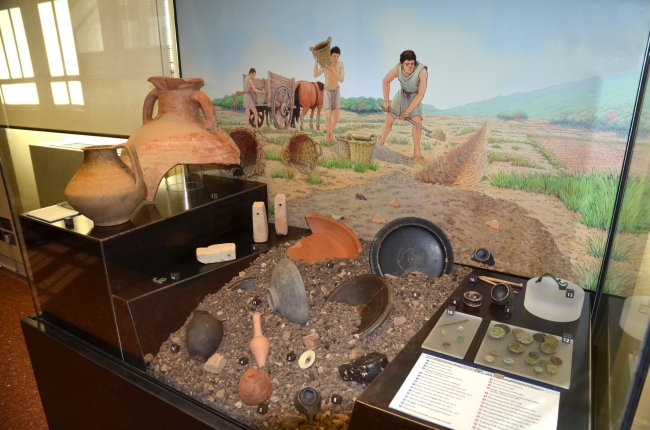
THE MEDIAEVAL PERIOD
The Quarter grows
In the 13th century, the population of this area outside the city
started to increase, as the San Gaudenzo monastery attracted peasants from the
nearby countryside to work its land. By this time, the city authorities had
already erected defences that included wooden palisades, ditches and ramparts,
signs of the economic and social importance that the new quarter was starting to
enjoy. With rule by the Malatesta family in the 14th and 15th centuries, Rimini
flourished both in its economy and its buildings. New inhabitants continued to
arrive from the countryside, settling in the city to work as tradesmen or
shopkeepers, and Rimini’s important road links allowed commerce to prosper. The
San Genesio quarter also grew, with groups of houses outside the walls replacing
the farmland. Historical evidence shows that new brickwork fortifications were
present from as early as the 14th century, when the quarter was closed about 300
metres to the south of the Augustus Arch by the San Genesio Gate, protecting the
Via Flaminia and access to the quarter, and inserted into the old wooden
palisade. In the direction of the city, the San Bartolo Gate was erected, to
protect the bridge over the River Ausa. During the 14th century, with the
constant increase of the population of the quarter and its buildings, often
associated with trades and crafts, work was started on new walls built in brick,
probably terminated around 1450.
The walls were reinforced by towers like that discovered behind the Palazzo
Ghetti, with a polygonal foundation filled with rubble and other materials to
resist against artillery fire.
From excavations to the mediaeval quarter
The archaeological excavations also revealed a road and the remains of
buildings with courtyards and refuse pits from the quarter in the 14th and 15th
centuries. The road, paved with gravel, cobblestones and other materials, led
from the Via Flaminia towards the walls, and was raised and repaired several
times, and probably enlarged around 1450.
A smaller alley wound away from this road between the shops and houses, and
several structures of the San Genesio quarter were discovered alongside it. On
one side there were buildings with the ground floor divided into two areas, one
for business activities as a shop or a tradesman’s workroom, or used for storage
or as a stable, and the other, with a brick hearth for cooking food, for use as
living quarters. Beside the buildings there were small courtyards, sometimes
with ditches for household wastes.
On the opposite side were the partial ruins of a building with more carefully
built walls, suggesting the rear of one of the courtyard houses that had their
entrances directly on a main street, in this case the Via Flaminia. This
building had a waste pit filled with domestic refuse, containing in particular
painted crockery for serving food and drink.
Materials
Various materials recovered during the excavations allow the daily life
of the quarter in the Middle Ages to be more fully understood. The waste pit of
the large courtyard house contained in particular three ceramic objects: a jug
with small floral motifs, used at the table to hold water or wine; a graffito
slipware bowl used to carry food to the table; and finally a small green glazed
pitcher, used to store food or to transport liquids. There were also several
fragments of ceramic cooking pots placed over the fire to prepare soups and
stews. Various pottery fragments attributable to the 14th and 15th centuries
were found on the road, together with a series of metal objects that included
several coins, shedding light both on the trade activities of the quarter and
the origin of travellers. Some of the objects came from the courtyards of the
houses, and in particular a few nails and a sickle, associated with everyday
household activities, for work in vegetable gardens and repairing buildings.
The walls and the Mediaeval tower
The excavations in the outer courtyard revealed a stretch of medieval
walls probably erected in the 14th century and completed in the 15th century by
the ruler of Rimini, Sigismondo Pandolfo Malatesta. These walls, which probably
replaced an earlier wooden palisade with a moat, protected the former San
Genesio quarter, which had grown outside the main city along the Via Flaminia, a
busy road lined with tradesmen’s shops and taverns. Built in brickwork, the
walls were about one and a half metres thick, and were topped by a parapet and
battlements to protect the defenders. Of the various towers built along the city
walls, the one discovered by the excavations was of particular interest, with a
large polygonal foundation filled internally with rubble to allow it to resist
artillery fire, one of several experiments in military architecture typical of
Sigismondo Pandolfo Malatesta, renowned during the Renaissance for his studies
in the arts of war.
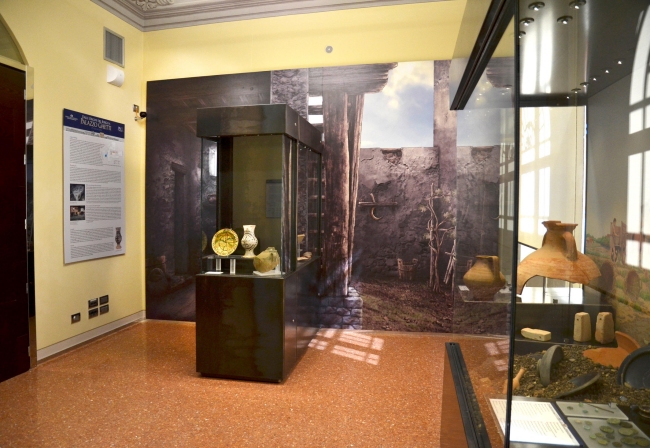
COMMENTARIES
MEDIAEVAL AND RENAISSANCE TABLEWARE
In the early dark ages, the lack of specialist kilns led to the
disappearance of luxury productions, which were limited to only “glazed”
pottery, in other words pottery covered in a thin coating of green or brown
glass, sometimes with relief motifs. This production continued for a
considerable period of time. After the year 1000, “graffita” pottery appeared.
This was covered in a white earth coating, called slip or engobe, on which
decorations were engraved and thus appeared as clay-coloured. These were
subsequently coloured with metallic oxides and covered in the glaze. Only later,
after the 13th century, did majolica appear. First, a vase in “biscuit” - that
is, simple clay fired just once - was made. The vase was then coated in vitreous
white enamel on which decorative motifs were painted. Subsequently, after the
final coating had been applied, the vase was fired a second time to obtain its
characteristics glazed appearance. So-called “archaic pottery” was decorated
with green cooper oxide and black manganese. Later cobalt blue appeared, to
which other colours were added as techniques developed. During the Renaissance
“istoriato-style” pottery became common and was decorated with complex scenes,
often taken from great paintings. In the Rimini area, production came mainly
from Faenza and Urbino. Later white enamel vases with small yellow and blue
images appeared and were known as “compendiario style”.
TYPES OF MEDIAEVAL HOMES
Excluding noble and palatial-style dwellings and veritable castles that
had mainly defensive functions, during the Middle Ages the houses of common
people seemed to have very specific characteristics. It is necessary to
distinguish between simple dwellings and buildings destined for use as workshops
or small stores too. Private homeowners were rare and to all intents and
purposes, should be considered landed gentry, whilst dwellings, which were very
small, were often dependent of monasteries or associations and were rented out
or given in use to employees. They usually consisted in a ground floor with a
hearth and stone or brick walls and a wood first floor that was used as sleeping
quarters; promiscuity was very common. There was almost always a small rear
courtyard, as was common in “courtyard” houses. In Rimini, wall foundations were
made of stone or fragments of brick and were only rarely made using new bricks.
They often had a “trellis-like” structure; in other words a structure with
wooden supports that held up the heterogeneous materials used for construction.
Shop owners and artisans worked on the ground floor, almost always in a single
room that was either common to or separate from the dwelling, often with a large
opening on the façade leading onto the street and with a large brick or wood
sales counter. The flooring on the ground floor was often hard clay with a
hearth of stone or brick, almost always reused. The partitions between the
floors and the stairs were always made of wood, whilst the roof was either wood
or straw, sometimes covered in roof tiles, even ancient ones. Inns and meeting
places in general were larger, with a common room, kitchens, storehouses,
stables and open spaces used for various purposes.
TYPES OF FORTIFICATIONS
Walls and fortifications in general evolved in line with the development
of siege techniques and machinery. The oldest and simplest defences consisted in
a simple rampart with external moat, sometimes with reinforcement elements and
often equipped at the top with wood palisades of varying thicknesses and
heights. The necessary entranceways had lateral protection elements that
developed into towers and mobile bridges for crossing the moat. Defensive
requirements meant that communities had to create walls in more resistant
materials, such as stone or brick, often “rubble masonry”. The walls had to be
fairly thick in order to support a communication walkway at the top and were
generally protected by battlements and had crenels. The great towers, which were
either square or polygonal, were designed to create specific defence points for
positioning machines of war. The invention of fire arms, in particular cannons,
forced changes to defensive systems. Great towers with corners could be damaged
by cannon balls, so mainly circular ones were built with the aim of creating
protections in fire-resistant material and replacing wood elements in order to
avoid the risk of fire as far as possible.

Building the wall that replaced the wooden palisade (14th - 15th century)
Exhibition promoters
BANCA MALATESTIANA
Credito Cooperativo Società Cooperativa
MINISTERO PER I BENI E LE ATTIVITÀ CULTURALI
Soprintendenza per i Beni Archeologici dell’Emilia-Romagna
Scientific and display project coordination
Renata Curina, Maria Grazia Maioli
Soprintendenza per i Beni Archeologici dell’Emilia-Romagna
Marcello Cartoceti, Chiara Cesaretti, Luca Mandolesi
adArte di Luca Mandolesi & C. snc – Rimini (RN)
Executive coordination
BANCA MALATESTIANA
Credito Cooperativo Società Cooperativa
Renata Curina, Maria Grazia Maioli
Soprintendenza per i Beni Archeologici dell’Emilia-Romagna
Marcello Cartoceti, Chiara Cesaretti, Luca Mandolesi
adArte di Luca Mandolesi & C. snc – Rimini (RN)
Scientific coordination for the restoration of archaeological materials
Mauro Ricci
Soprintendenza per i Beni Archeologici dell’Emilia-Romagna